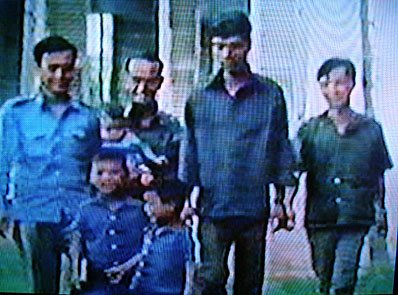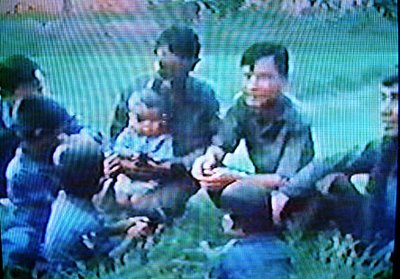 The screen capture is poor but so is the quality of my Year Zero dvd, but these are the 4 male survivors with the children in early 1979. Vann Nath is the tallest of the men.
The screen capture is poor but so is the quality of my Year Zero dvd, but these are the 4 male survivors with the children in early 1979. Vann Nath is the tallest of the men.
I am a little bit confused, though it doesn't take much to befuddle me sometimes! It's concerning the recent flurry of press talk about the
child survivors of Tuol Sleng, aka S-21, once the Khmer Rouge took flight as the Vietnamese army rolled into Phnom Penh at the beginning of 1979. It's been suggested that the fact that children were amongst the survivors of the horrific Tuol Sleng prison was only really identified when the Vietnamese recently donated archival footage a couple of months ago, of the first few days after Tuol Sleng had been liberated. Bullshit. Even I knew there were child survivors of Tuol Sleng way back in 1979, as footage of them appeared on John Pilger's documentary Year Zero: The Silent Death of Cambodia, when it was aired in October of that year. Four male survivors including Vann Nath and Ung Pech are shown with four tiny boys, as Pilger relates that just eight people survived from the thousands killed at the prison. Two of the boys, brothers Norng Chanphal and Chanly, have now been identified and have stepped forward to offer themselves as witnesses for the forthcoming trial of the S-21 chief Duch. In addition, Vietnamese photographer Ho Van Tay is helping in the hunt for the children, as he was one of the very first people to enter Tuol Sleng after the Khmer Rouge evaporated, and kept in touch with some of the children during the 1980s. It's his pictures that hang on the walls of the individual cells of Block A. So my question is, had no-one thought to seek out these children before now, and it sounds like the answer to that question is a resounding no.
 Another poor quality screen capture but it shows the 4 men and the 4 young children, quoted as S-21 survivors by John Pilger in 1979
Another poor quality screen capture but it shows the 4 men and the 4 young children, quoted as S-21 survivors by John Pilger in 1979Labels: Khmer Rouge, Tuol Sleng
 The screen capture is poor but so is the quality of my Year Zero dvd, but these are the 4 male survivors with the children in early 1979. Vann Nath is the tallest of the men.
The screen capture is poor but so is the quality of my Year Zero dvd, but these are the 4 male survivors with the children in early 1979. Vann Nath is the tallest of the men. Another poor quality screen capture but it shows the 4 men and the 4 young children, quoted as S-21 survivors by John Pilger in 1979
Another poor quality screen capture but it shows the 4 men and the 4 young children, quoted as S-21 survivors by John Pilger in 1979

2 Comments:
Uncovering Pol Pot’s Horrors through the Eyes of Camera Lenses
- by Dacil Q. Keo
PhD Student at University of Wisconsin-Madison, USA
Vietnamese cameraman Ho Van Tay, now 76 years old, traveled to Cambodia during two significant moments in the nation’s modern history: in 1976 when the country was under the genocidal control of the Khmer Rouge regime and in 1979 when Vietnamese forces invaded, thereby ending the regime and its brutality. According to Ho, he was among the first to discover the Tuol Sleng prison, the highest level security prison under the Khmer Rouge responsible for as many as 14,000 deaths. His video footage of the prison shot in January 1979 includes bloody walls, fat chickens pecking and consuming human corpses, and tiny dark jail cells, were donated to the Documentation Center of Cambodia (DC-Cam) in late December 2008 along with other archival films totaling nearly 500 miuntes of archival footage. These films provide undisputed evidence of Pol Pot’s horrors.
In a recent interview with DC-Cam’s Dany Long in Vietnam on January 20, 2009, Ho recounts his experiences in Cambodia in 1976 and 1979 and the resulting films he produced back in his office at the Ho Chi Minh City Television (HTV) station. His films of the country, its people, and in particular the infamous Tuol Sleng prison (code named S-21 under the Khmer Rouge) mostly document the cruelty and tragedy of Cambodia , but in a few cases, also its resilience.
In 1976, Ho was in his early 40s and on his way to neighboring Democratic Kampuchea upon an official invitation. Arriving with a group of Vietnamese reporters, Ho recalls that he was greeted warmly by officials in the capital of Phnom Penh . Things quickly changed however. During his stay which lasted over two weeks, he and the other reporters were tightly controlled in their movement and work. Their lodging was patrolled by two Khmer Rouge cadres and they could not leave unless a car came to pick them up, taking them to predetermined places. According to Ho, Pol Pot wanted the reporters to spread the news that since his takeover in 1975, the country and its people were stable and thriving. What Ho saw witnessed instead were deserted homes in Phnom Penh, scared hotel workers in Siem Reap, and a pool of crocodiles being fed human corpses (apparently Khmer Rouge leaders enjoyed raising crocodiles). When he tried to film such scenes however, the cadres who escorted him blocked his camera lenses with their hands. Ho did not dare to oppose them.
Three years later Ho returned to Cambodia with Vietnamese troops when they invaded and quickly overtook the country in January 1979. Ho’s discovery of the S-21 prison was rather accidental. As he and his crew, which consisted of an assistant and a driver, were driving near the vicinity of the prison compound, they were confronted with the stench of decomposing matter. In searching for the source of this pungent odor, they found an abandoned compound surrounded by barbed wires. It was S-21, Pol Pot’s interrogation and torture center. After alerting the Vietnamese troops about his finding, it appeared that he and his assistant were not alone in S-21. Five children were inside one of the buildings, some crying and some asleep. They were the children of Khmer Rouge cadres that Pol Pot had sent to the prison. There in front of Ho and the Vietnamese troops, they appeared emaciated and on the verge of death. Female Cambodian troops were called over to take care of them.
During his 1979 stay in Cambodia , Ho encountered other Cambodians which would later become the subject matter in his collection of films on Cambodia . There was a little boy that Ho first located in the province of Siem Reap , and later filmed in Phnom Penh . When Ho first met the kid, he was withered, anxious and had a dented scar on his head. The little boy said that the Khmer Rouge had slit his throat, beaten him over the head, and splashed hot water on him. Nearly five years later when Ho returned to Cambodian in 1984, he met the kid again and filmed his new and much improved condition. The little boy had grown up and was dressed in a school uniform. Ho even commented that he had gotten fat.
Ho made another film called, “The Rebirth of an Art Form.” In this film, a female survivor who studied classical dance in the Soviet Union prior to 1975 talks about her hardships under the Khmer Rouge regime. Ho also produced a documentary on the general state of children of Cambodia , inspired by the site of a pale and skinny kid sitting alone near the river dock in Neak Leang in 1979. This film went on to win an award.
One film in particular focused on a non-Cambodian. In 1979, Ho found a Japanese woman walking along the national road in a rather confused state. She was the wife of the former Cambodian ambassador to Japan . After her husband was killed by the Khmer Rouge, she was imprisoned and forced to take care of the children. Ho helped the woman by informing the Japanese newspaper Asahi about her when he returned to Vietnam . Japan soon sent her family and a plane to take her back to her home country. Ho recalled that it was a dramatic and elaborate reception. Half a year later, Ho received a letter from the woman which he keeps next to the photograph taken with her.
Several of Ho’s films however are not in his possession; they remain with HTV. There are also approximately 70 photographs taken of S-21 in 1979 which HTV still holds.
DC-Cam has invited Ho to Phnom Penh on February 15, 2009 to attend the hearing of Duch, the notorious leader of the S-21. Duch, whose real name is Kaing Guek Eav, was charged with crimes against humanity in July 2007 and will be prosecuted by the Extraordinary Chambers in the Courts of Cambodia (ECCC), known informally as the Khmer Rouge Tribunal. Ho’s filming experiences of the Khmer Rouge regime now comes full circle from his 1976 tour of Democratic Kampuchea, his 1979 discovery of S-21, his update on the country in 1984, and now to his upcoming witnessing of the trial of S-21’s leader. Although now retired, there is a good chance that Ho still has within him the desire to continue, and in a sense complete, his filming of Cambodia . His return to Cambodia on February 15, 2009 will mark another visit to the country during an important moment in its history.
Note: Ho Van Tay will meet Norng Chan Phal (a child survivor of S-21 -- he was among the five children found by Van Tay in 1979) for the first time in 30 years on Monday 16, 2009 at the Club of Cambodian Jounalist. For details, please contact Mr. Roat at 012 267 277.
You know i have asked myself that question for so long - about finding the children... why so long - but i guess better late than never!
Georgie
Post a Comment
<< Home